The Vibrant World of Parakeet Coloring
Parakeet coloring has become increasingly popular over the years, and I'm here to show you just how fun and vibrant it can be. Let's get into the amazing world of parakeet coloring together!

Parakeets, with their vivid feathers and playful personalities, have captured the hearts of bird enthusiasts around the world. These amazing little birds come in a rainbow of colors, from the light green of their wild ancestors to the dazzling blues, yellows, and even pinks found in domesticated varieties. Understanding the genetics and beauty of parakeet coloring can enhance the experience of both current and prospective parakeet owners.
Key Takeaways:
- Parakeet colors are influenced by a combination of dominant and recessive genes, resulting in a wide array of color variations.
- The basic color scheme of parakeets ranges from light green to dark green, with mutations leading to blue, grey, violet, and many other shades.
- Parakeet coloring pages and coloring books can be a fun way for kids and adults alike to appreciate the diversity of these birds' feather colours.
The Genetic Palette: Understanding Parakeet Colors
Parakeets, or budgies as they are often known, exhibit a fascinating array of color mutations that can be traced back to their genetic makeup. The wild-type coloration of these very social birds is a light green shade, which serves as a camouflage in their native Australian habitats. This color is the result of yellow pigmentation overlaying a blue base.
The color variations we see in domesticated parakeets are due to selective breeding, which has amplified certain traits. The dominant gene is responsible for the most common colors, while the recessive gene can create unexpected and less common shades when two parakeets carrying it are bred together.
A Spectrum of Shades: From Light Green to Dark Green and Beyond
The light green base color of wild parakeets has been diversified through breeding to include dark green, olive, and other darker shades. These colors are often intensified or faded depending on the combination of genes present. For example, the dark factor can deepen the green to a rich, forest hue, while the grey factor can mute the green to a more subdued shade.
Blue parakeets are the result of a color mutation where the yellow pigmentation is absent, allowing the blue base to show through. This mutation can result in various shades of blue, from sky blue to cobalt and mauve. The violet factor can further modify these blues, adding a regal purple sheen to the bird's feathers.
The Role of Pigmentation: Yellow Faces and Beyond
Yellow pigmentation plays a crucial role in the color scheme of parakeets. It is responsible for the yellow faces that are characteristic of many color mutations. In some cases, the yellow can be so prominent that it covers most of the bird's body, resulting in a bird that appears almost entirely yellow.
In contrast, birds with the recessive pied mutation may have irregular patches of color where the yellow pigmentation is absent, creating a unique and striking pattern. These birds often have a mix of clear and colored feathers, which can make each individual bird look quite distinct.
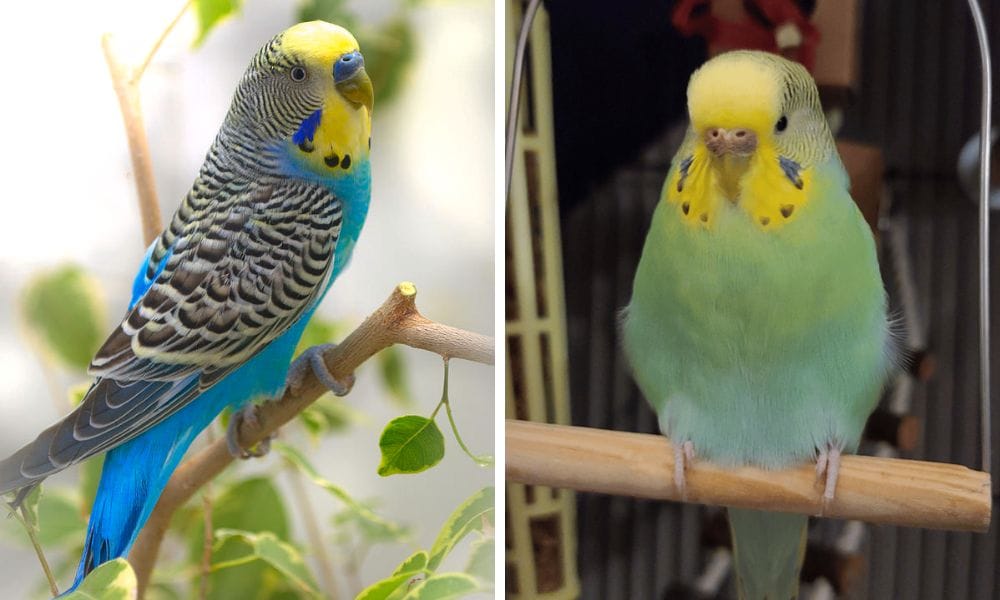
The Pied Beauty: Dominant Pied and Recessive Pied Mutations
The dominant pied mutation in parakeets creates a bird with clear areas on its body, usually on the belly and back. These clear areas lack color, giving the bird a pied appearance. This mutation can occur in any color variety, adding an extra layer of complexity to the bird's overall appearance.
Recessive pied parakeets, on the other hand, have a more random distribution of clear and colored feathers. This mutation can result in birds with dramatic contrasts and patterns that are highly sought after by breeders and enthusiasts.
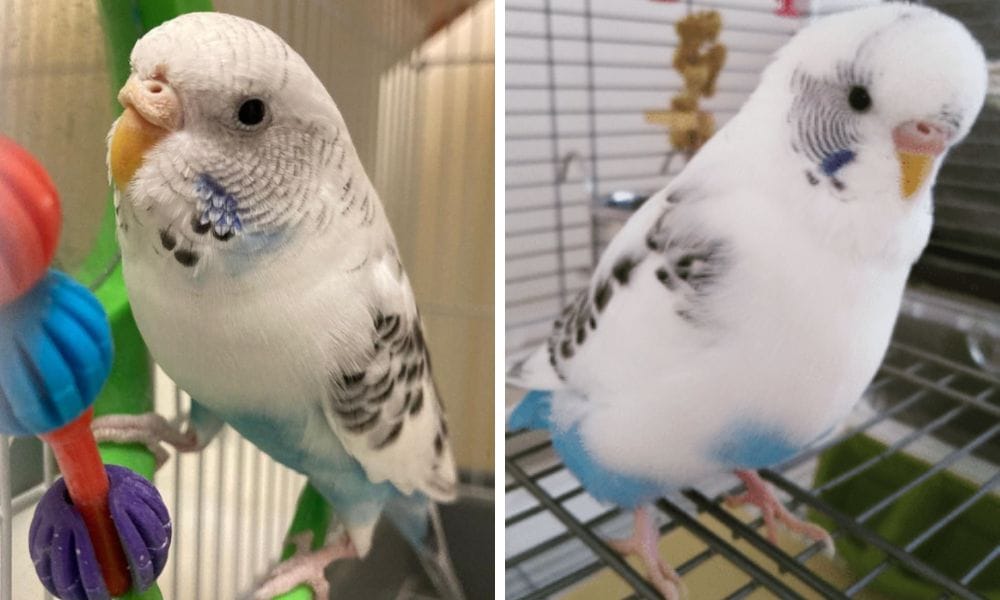
The Allure of Blue: Exploring Blue Parakeet Varieties
Blue parakeets are among the most popular color mutations. They range from the light and airy sky blue to the deep and intense cobalt. The blue coloration is a result of a lack of yellow pigmentation, allowing the blue base color to shine through.
These blue varieties can also be influenced by other factors, such as the grey factor, which can create a steel-blue appearance, or the violet factor, which can add a luxurious purple tint to the bird's feathers. The Intricacies of Yellow Pigmentation in Parakeets Parakeets exhibit a dazzling array of colors, but the presence of yellow pigment is particularly fascinating. This pigment, known as psittacofulvin, is responsible for the vibrant yellow face and body markings that many parakeet lovers adore. Unlike other birds, where the color might come from a diet rich in carotenoids, parakeets synthesize their own yellow pigment. This unique ability means that the intensity of the yellow can vary from bird to bird, influenced by genetics and overall health.
The yellow face mutation in species like the budgie is a prime example of how intricate genetic factors can be. In these birds, the yellow pigment can overlay the base color, creating a stunning contrast that is highly sought after by breeders. For those who love parakeets, the yellow face variant is often a favorite, not just for its beauty but also for the complexity it adds to the breeding process. Understanding how these yellow pigments are inherited can be both a challenge and a delight for those deeply invested in the hobby.
Parakeet Coloring Pages: A Fun and Educational Tool Coloring pages have become a popular way for enthusiasts of all ages to appreciate the beauty of parakeets. These coloring book activities are not only a fun pastime but also serve as an educational tool to learn about the different color mutations and species. By downloading a parakeet coloring page, individuals can get creative with so many colors, bringing to life pictures of these vibrant birds on paper. It's a great way to engage with the hobby, especially for families with children who love parakeets.
Moreover, coloring books dedicated to parakeets can help future breeders and owners understand the variety of colors these birds come in. From the common light green to the rarer gray shades, a coloring book can illustrate the spectrum of parakeet hues in a tangible, interactive format. For those looking to print their own coloring pages, there are many resources available online that offer a range of pictures, from baby parakeets to full-grown species like the cockatiel and budgie. These resources often include females and males, showing the sometimes lighter coloration found in female birds. Capturing the Rainbow: Photographing Parakeet Hues Parakeets, with their vivid plumage, are a photographer's dream. Capturing the true essence of their coloring in a picture can be both challenging and rewarding. The key is to use natural lighting to avoid washing out the vibrant hues that make each breed unique. A high-resolution camera with a macro lens can help you get detailed shots that showcase the intricate patterns and shades of your feathered friend. Sharing these images on social media or photography platforms can not only highlight the beauty of your parrot but also inspire others in the avian community.
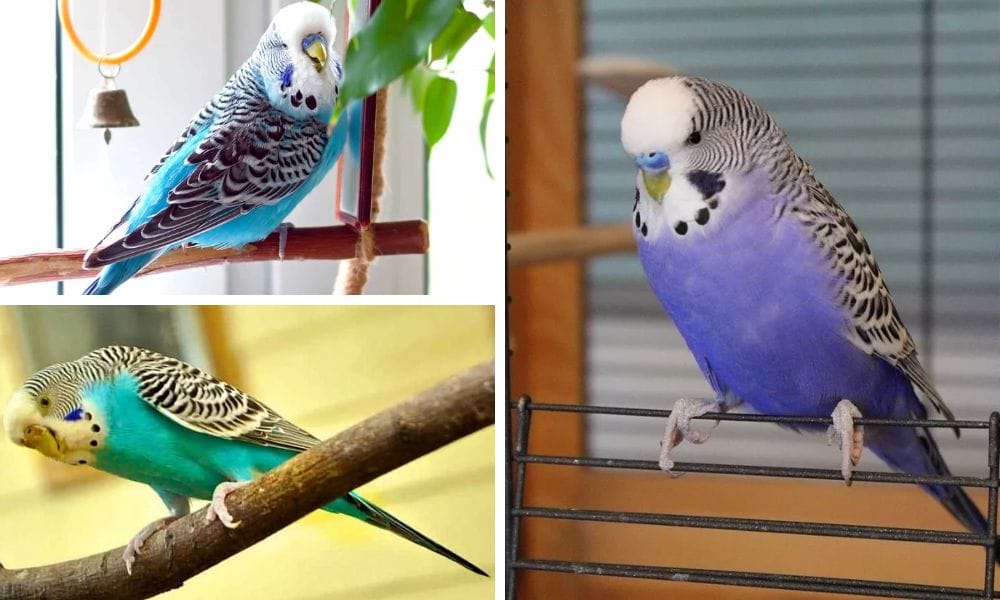
When attempting to photograph your parakeet, patience is paramount. These lively birds may not always cooperate with your artistic vision, so it's essential to wait for the right moment. Engaging with your parrot and ensuring it is comfortable with the camera can lead to more natural and expressive photos. Once you've captured that perfect shot, consider offering it as a download for fellow parakeet enthusiasts or using it to create custom wallpapers or prints. Your stunning photographs can help others appreciate the diverse beauty of these birds and may even assist in identifying specific breeds.
Parakeet Profiles: A Deep Dive into Breed Characteristics Each parakeet breed boasts its own unique set of characteristics, and understanding these can enhance the care and companionship they offer. For instance, the Budgerigar, commonly known as the budgie, is renowned for its sociable nature and ease of training, making it a popular choice for pet owners. On the other hand, the Monk Parakeet, with its quaker-like chatter, is known for its exceptional mimicking abilities. By delving into the specific traits of each breed, owners can tailor their care routines and environment to better suit their parakeet's needs, leading to a happier and healthier bird.
Creating detailed profiles for each breed can be an invaluable resource for current and prospective parakeet owners. These profiles could include information on temperament, dietary preferences, and ideal living conditions. Additionally, offering these profiles as a download can make them easily accessible to a wider audience. By educating people on the nuances of different parakeet breeds, we can foster a more informed and dedicated community of parrot enthusiasts. This knowledge not only enriches the bond between owner and pet but also promotes responsible pet ownership and the well-being of these captivating creatures.
The Rarity of Recessive Colors: Grey, Greywing, and Clearwing
Recessive color mutations in parakeets are less common but highly prized for their unique beauty. Grey parakeets, for example, have a diluted coloration that gives them a soft, ethereal look. Greywing parakeets have grey markings on their wings, while clearwing parakeets have almost transparent-looking feathers.
These recessive colors often require careful breeding strategies to produce, as both parents must carry the recessive gene for the trait to be visible in their offspring.
The Pink Parakeet Phenomenon: Understanding Rare Color Mutations
Pink parakeets are a rare and delightful color mutation that can occur in these birds. This coloration is often the result of a combination of mutations that reduce the intensity of the green and blue pigments, allowing the natural pinkish hue of the bird's skin to show through the feathers.
These pink parakeets are a testament to the incredible diversity of color mutations that can be achieved through selective breeding and genetic understanding.
Parakeet Coloring Pages: A Creative Way to Explore Colors
Parakeet coloring pages offer a fun and educational way to explore the different colors and patterns of these birds. These pages can be found in coloring books or as free pdf downloads online, providing an interactive experience for kids and adults alike.
Coloring these pages can help individuals learn about the various color mutations and how they combine to create the vibrant plumage of these birds. It's also a relaxing activity that allows for artistic expression and appreciation of parakeet diversity.
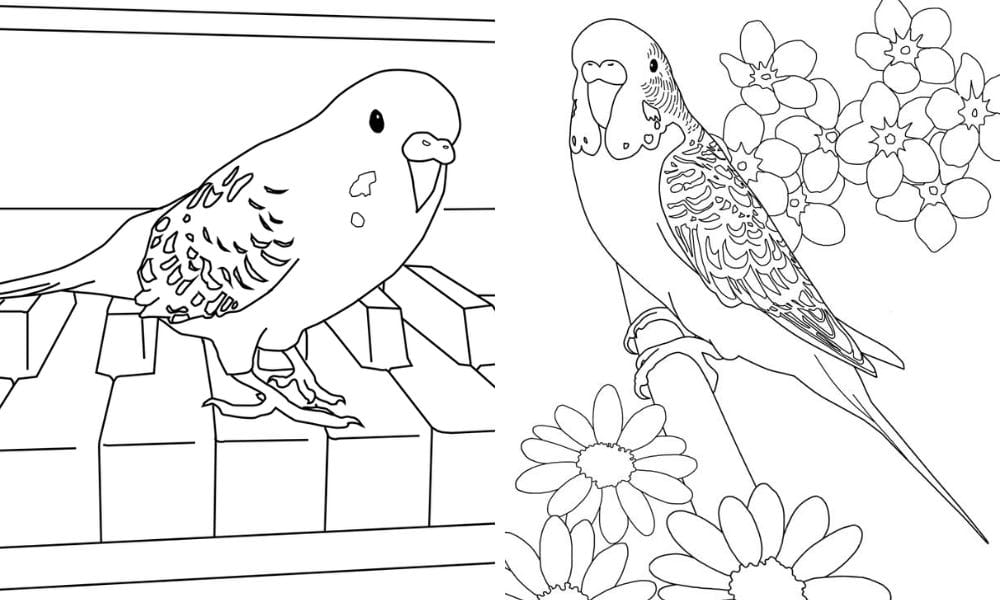
The Impact of Lighting on Parakeet Colors
Lighting can have a significant impact on how we perceive the color of parakeet feathers. In natural sunlight, the colors can appear more vivid and true to life, while artificial lighting may alter the appearance, making some colors look faded or less intense.
Understanding the effect of lighting is important for both breeders and pet owners, as it can influence how the birds are presented and appreciated. It's also crucial when taking pictures of parakeets to capture their true colors.
Parakeet Color Genetics: A Case Study
To illustrate the complexity of parakeet color genetics, let's consider a case study of two budgies, one with a dominant gene for blue and the other carrying a recessive gene for grey. When these two birds are bred together, their offspring could exhibit a range of color variations, from pure blue to a mix of blue and grey feathers.
This case study highlights the unpredictable nature of parakeet breeding and the excitement that comes with waiting to see the colour babies of a new clutch.
Summary
Parakeet coloring is a fascinating subject that combines genetics, selective breeding, and a touch of luck. From the light green of their wild ancestors to the myriad of color mutations like dark green, blue, grey, and even pink, parakeets truly are a rainbow of possibilities. Whether you're a breeder, an owner, or simply someone who loves parakeets, understanding the science and beauty behind their vibrant feathers can deepen your appreciation for these awesome pet birds.
If you want to read more about parakeets we put together our Parakeeet Guide here.
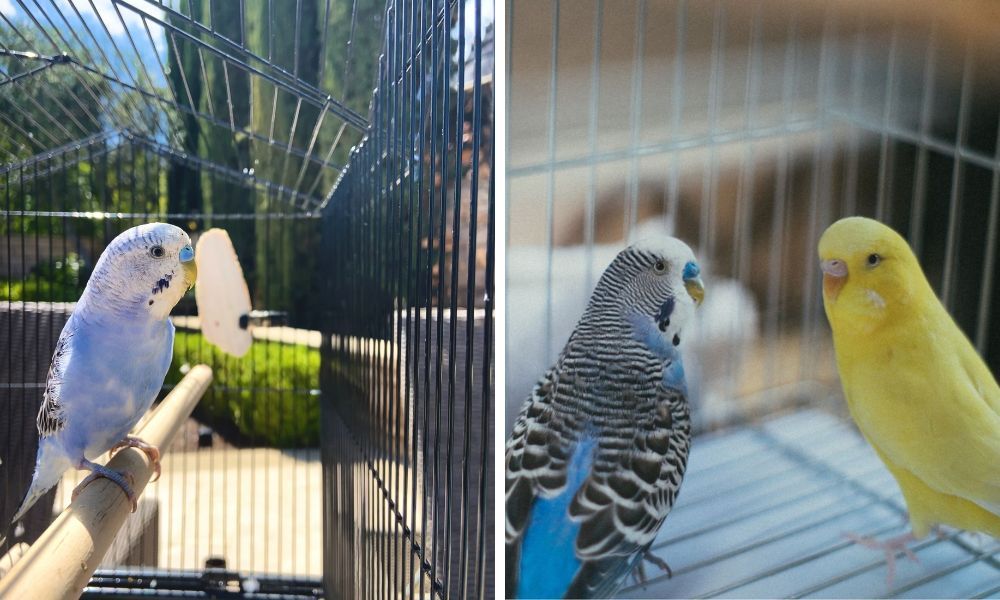
FAQ Section
Q: What determines the color of a parakeet? A: The color of a parakeet is determined by a combination of genetic factors, including dominant and recessive genes. The base color is influenced by yellow pigmentation and a blue or green shade, with mutations leading to a wide range of colors and patterns.
Q: Can two green parakeets have blue offspring? A: Yes, two green parakeets can hant to buy from reputable breeders who prioritize the health and well-being of their birds.ave blue offspring if they both carry the recessive gene for the blue color mutation. The absence of yellow pigmentation allows the blue base color to be visible.
Q: Are there any health concerns associated with certain parakeet colors? A: Generally, the color of a parakeet does not directly correlate with health issues. However, some color mutations may be linked to genetic conditions that could affect a bird's health.

